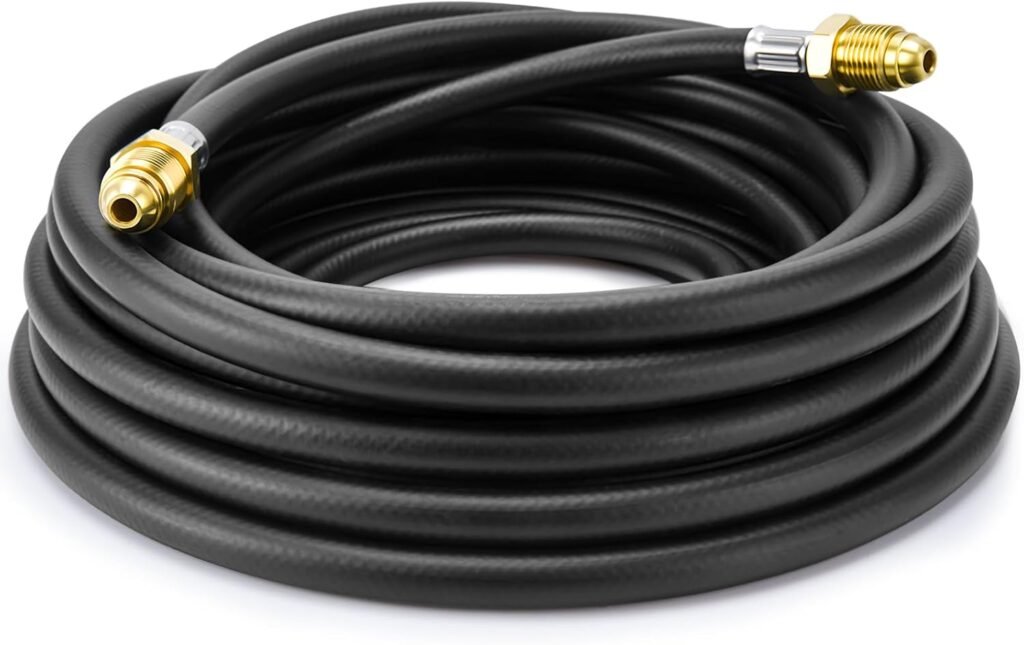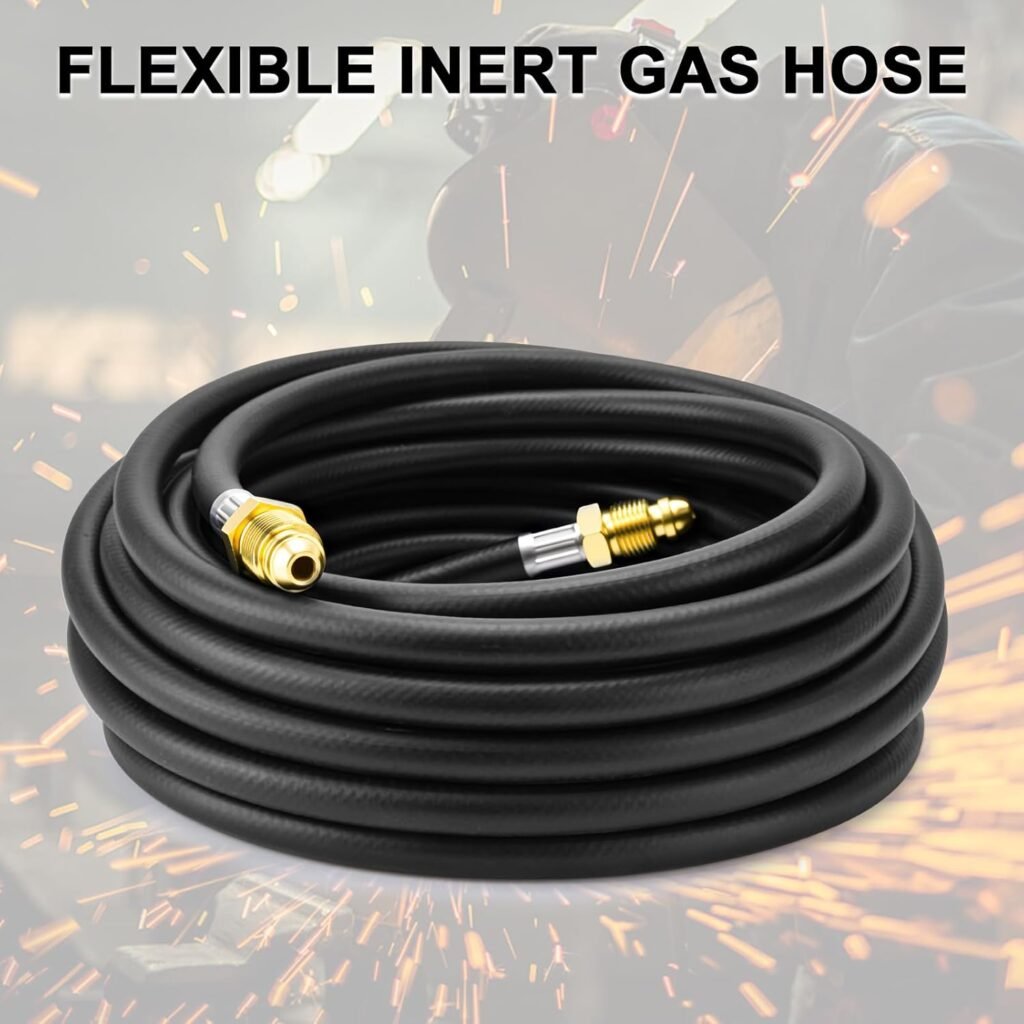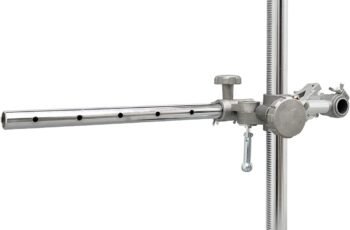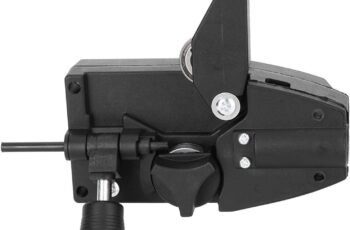Ad Blocker Detected
Our website is made possible by displaying online advertisements to our visitors. Please consider supporting us by disabling your ad blocker.
Looking for a durable, flexible argon hose that keeps your MIG and TIG welding setup reliable and easy to use?
Product Overview: Argon Hose, Welding Gas Hose 30FT 5/8″X18 Male Inert for MIG TIG Welding Flowmeter Regulator Adapter Hose, Black
You’ll find this argon hose is designed with practical shop use in mind: 30 feet of premium rubber tubing fitted with precision-machined brass connections to handle argon and other inert gases. It aims to give you stable flow, fewer leaks, and easy handling across a range of welding tasks whether you’re working in a small garage or a busy fabrication shop.
What this product promises
The hose promises strength, flexibility, and compatibility with most common welding equipment. It’s rated for 300 PSI working pressure, resistant to flame and oil, and built to minimize kinks and tangles while you move between your regulator and torch.
Quick Specs and Feature Breakdown
Below is a compact table to help you scan the most important specs. This gives you the details at a glance and why they matter to your work.
| Feature | Specification | Why it matters to you |
|---|---|---|
| Length | 30 ft | Gives extended reach so you can move around without constantly moving the cylinder. |
| Working Pressure | 300 PSI | Handles standard shop pressures for argon and inert gas usage without performance loss. |
| Fittings | Crimped 1/4″ and 5/8″ male (5/8″X18) brass fittings on both ends | Common thread sizes ensure wide compatibility with regulators, flowmeters, and torches. |
| Material (Hose) | Premium-grade rubber | Provides flexibility, resists cracking, and reduces kinking. |
| Material (Fittings) | Precision-machined brass | Corrosion-resistant and forms reliable, leak-resistant seals. |
| Gas Compatibility | Argon, Argon/CO2 mixes, Helium, other shielding gases | Works with the gases you commonly use for MIG and TIG applications. |
| Safety Properties | Flame- and oil-resistant, self-extinguishing | Adds protection in hot or harsh shop environments. |
| Warranty | 6 months | Short-term coverage for defects or early failures. |
You can use this table to quickly decide whether the basic specs meet your workflow and equipment needs.
Build Quality and Materials
You’ll notice the hose is made from premium-grade rubber which balances flexibility and toughness. The rubber resists cracking and abrasion so the hose will tolerate typical shop wear without splitting or drying out prematurely.
The brass fittings are machined to a consistent tolerance so you don’t get cross-threading or loose connections that cause leaks. Brass is also corrosion-resistant and won’t rust the way steel fittings sometimes do, which helps maintain a secure seal over time.
How that affects durability
Because of the rubber and brass combo, the hose handles repeated movement, draping over equipment, and coiling up for storage without failing quickly. You’ll find it more reliable than cheap vinyl hoses that get brittle and more serviceable than some lightweight plastic hoses that kink and restrict flow.
Performance and Pressure Rating
With a 300 PSI working pressure, this hose sits squarely in the range you need for most argon and inert gas welding applications. You’ll get smoother, uninterrupted gas flow under typical shop pressures, which helps keep your shielding consistent and weld quality stable.
Realistic flow behavior
In practice, the hose’s internal diameter and flexible wall let gas move freely without sharp pressure drops. That matters when you’re trying to maintain a precise puddle on TIG or keeping a clean bead on MIG — inconsistent shielding gas will show up as porosity or oxidation, and this hose is built to prevent that.
Compatibility and Fit
This hose is fitted with crimped 1/4″ and 5/8″X18 male brass fittings on both ends, making it compatible with a wide range of regulators, flowmeters, torches, and adapters you likely already own. It’s also suitable for argon/CO2 mixes, helium, and other common shielding gases, so you won’t be swapping hoses when you switch processes.
How to match it to your equipment
You should check your regulator and flowmeter threads before buying; most common TIG and MIG setups accept 5/8″ X 18 connections, and the included 1/4″ end covers some adapter needs. If you use specialized quick-disconnects, you may want to add the appropriate adapters, but the brass male fittings make that process straightforward.
Safety Features
You’ll appreciate the hose’s flame- and oil-resistant construction plus its self-extinguishing characteristics. Those properties reduce fire risk around hot zones, grinding sparks, or accidental torch contact. The hose is also engineered to resist leaks under high-pressure flow, which reduces wasted gas and the danger of an accumulation of flammable mixtures in confined spaces.
Practical safety tips while using the hose
Always ensure fittings are tightened correctly and leak-checked with a soapy water solution when you first hook up the hose. Keep the hose away from direct flame or extreme heat sources and replace it immediately if you spot any burns or deep abrasions.
Flexibility, Handling, and Storage
You’ll find the hose notably flexible even at 30 feet long. That flexibility translates to easier routing across your workspace without excessive stress at the fittings. The hose is designed to be kink-resistant and tangle-free so you can coil it up for storage and uncoil it quickly when you need it.
Transport and storage convenience
Its lightweight, coiled form means you can carry it around your shop or transport it to job sites without a lot of bulk. Coil it neatly and secure it with a strap or hook; it won’t take up significant storage space, and it won’t develop permanent kinks if you store it properly.
Installation and Connection Tips
When you install the hose, make sure to match the threads and start hand-tightening before using a wrench to finish the connection. For flare fittings, engage threads carefully and avoid cross-threading. Use wrenches on brass fittings to snug connections — you’ll feel when it seals properly. Don’t over-tighten, because that can damage fittings or strips threads.
Leak checking and startup recommendations
After installation, always perform a leak test using a soap-and-water mixture or a commercial leak detector. Open your cylinder valve slowly and pressurize the hose while checking all joints. If you see consistent bubbling, isolate the leak and re-tighten or replace the faulty fitting.
Maintenance and Care
You’ll want to inspect the hose periodically for cracks, bulges, or abrasions. Regularly check fittings for corrosion or loosening. If the hose gets oily, clean it with a mild detergent and dry it thoroughly, as oils and solvents can degrade some rubber compounds over time.
Long-term care to extend lifespan
Avoid leaving the hose under UV exposure or in direct sunlight for extended periods. If you move hot parts or torch tips near the hose, shield it with a leather guard or heat-resistant wrap. Replace the hose if you notice significant wear, because small leaks under pressure can quickly worsen.
Real-World Use Cases
This hose fits a wide range of applications: from hobbyist TIG welding on thin-gauge metals to professional MIG welding in a small fabrication shop. You can use it for automotive repairs, metal art, structural work, and hobby fabrication projects. It’s also handy for portable welding rigs since the 30-foot length gives you room to set up away from the cylinder.
Examples of typical projects
- Shielding argon for TIG welding stainless steel, aluminum, and titanium components.
- Providing Argon/CO2 mix for MIG welding automotive panels or small fabrication jobs.
- Portable welding at a job site where you need extended reach without moving the cylinder constantly.
Pros and Cons
You’ll find a balance of strengths and a few trade-offs—no product is perfect, and it’s useful to weigh them together.
Pros
- Durable rubber construction resists abrasion and cracking, so it lasts longer than cheap vinyl hoses.
- Brass fittings provide secure, leak-resistant connections and durability against corrosion.
- 30-foot length gives you flexibility and less need to constantly move the gas cylinder.
- Compatible with Argon, Argon/CO2 mixes, Helium, and other shielding gases you commonly use.
- Flame- and oil-resistant plus self-extinguishing features improve safety in demanding shop environments.
- Kink- and tangle-free design makes handling simpler and storage easier.
- Lightweight and easy to transport, useful for mobile work.
Cons
- If you need a non-standard quick-disconnect system, you might need adapters to fit specialty equipment.
- The 6-month warranty is short compared to some premium hoses that offer longer coverage.
- Rubber hoses can be slightly heavier than braided or composite alternatives, which may matter if you’re minimizing weight for portable setups.
- The product may not include multiple adapter types; depending on your hardware, you may need to buy extras.
How It Compares to Alternatives
When you compare this argon hose to other types, you’ll see clear trade-offs between price, durability, and flexibility.
Rubber vs PVC or vinyl hoses
Rubber outperforms PVC and vinyl in toughness, temperature tolerance, and resistance to cracking. You’ll get longer service life from rubber even though it may cost a bit more and weigh slightly more.
Brass fittings vs cheap plated fittings
Brass fittings resist corrosion and provide a consistent seal. Cheaper plated fittings can corrode or strip threads faster, leading to leaks and replacement costs. Brass also handles repeated tightening better.
Standard threaded fittings vs quick-disconnect systems
Standard threaded fittings are universal and reliable; quick-disconnect systems offer convenience but can add cost and require matching hardware. If portability and fast swapping of torches are important, you’ll need to consider adapters or a separate quick-connect setup.
Who Should Buy This Hose
You should consider this hose if you:
- Frequently perform TIG and MIG welding with argon or argon mixes.
- Want a long hose (30 ft) to work around larger benches or move between parts without relocating a cylinder.
- Prefer a durable, flame-resistant hose with brass fittings for reliable, leak-free connections.
- Need a flexible, tangle-free line that’s easy to store and transport.
- Want compatibility across common welding equipment without specialty connectors.
Troubleshooting Common Issues
Even with a quality hose, you will sometimes run into problems. Here’s how you can handle common issues quickly.
Issue: Audible hiss or obvious leak at fitting
Check that threads are engaged correctly and tighten with a wrench. If the leak persists, disconnect, inspect the flare or seat, and re-seat the connection. Replace any damaged ferrule or fitting rather than relying on over-tightening.
Issue: Reduced gas flow or weird pressure behavior
Confirm the cylinder valve is fully open and the regulator is set correctly. Check for kinks or internal collapse in the hose, particularly if it’s been stored at a sharp bend. Also ensure no debris is blocking the regulator or flowmeter.
Issue: Hose becomes sticky or shows surface degradation
This can be caused by chemical exposure or oils. Clean the hose with mild soap and water and avoid using harsh solvents. Replace the hose if the material softens or significantly degrades.
Frequently Asked Questions (FAQ)
You probably have a few specific questions before buying. Here are the common ones answered.
Q: Can I use this hose with CO2 alone?
A: The hose is intended for inert gases such as argon and argon/CO2 mixes. While it can handle many shielding gases, check your regulator and fittings for compatibility with pure CO2 setups because CO2 setups sometimes use different fittings and higher flow/pressure behavior.
Q: Is 300 PSI sufficient for heavy-duty welding jobs?
A: For most TIG and MIG welding applications with common regulators and flow settings, 300 PSI working pressure is adequate. If you operate at significantly higher pressures, verify system requirements, but most bench and portable setups don’t exceed this rating.
Q: Can I leave the hose connected to the cylinder long-term?
A: It’s fine to leave it connected if you use proper cylinder storage and valve safety. However, inspect the hose periodically for wear and leak-check connections before use. For long-term storage, coil and secure it out of direct sunlight and away from sharp objects.
Q: What does the 6-month warranty cover?
A: The 6-month warranty typically covers manufacturing defects and early failure under normal use. Read the seller’s warranty terms for details about returns, conditions, and what voids coverage (for example, misuse or modification).
Q: Are any adapters included?
A: The hose itself has crimped 1/4″ and 5/8″X18 male fittings; if you need different connectors or quick-disconnect fittings, you may need to purchase adapters separately.
Buying and Setup Checklist
Before you finalize your purchase and install the hose, use this checklist to make sure you have everything covered.
- Confirm your regulator and flowmeter thread types match 5/8″X18 or that you have proper adapters.
- Ensure your workspace can safely store and use compressed gas cylinders.
- Have a leak detection solution (soap/water or commercial spray) on hand for initial tests.
- Keep basic wrenches available to tighten fittings properly without over-torquing.
- Plan for proper storage away from direct UV and heat sources to preserve hose life.
Practical Tips to Extend Hose Life
You’ll get more out of your hose by following a few simple practices.
- Don’t drag the hose across sharp edges or abrasive surfaces; use protective sleeves if needed.
- Coil the hose in large loops rather than tight bends to avoid permanent memory and stress points.
- Keep a small tag or label with the installation date so you can track age and service life.
- Use a leather or heat-resistant shield near areas where the hose passes close to torches or hot metal.
- Perform a visual inspection before each use and a leak test after any reconnection.
Environmental and Storage Considerations
Store the hose in a cool, dry space. Avoid prolonged exposure to sunlight or ozone sources which can degrade rubber compounds. If you work outside a lot, consider getting a protective cover or storing the hose in a toolbox between uses.
Transport tips
When you transport the hose, coil it loosely and secure it with a strap. Avoid leaving the hose flopping in the back of a truck bed where it can be chewed by vibration or caught under tools.
Final Verdict and Recommendation
You’re getting a practical, shop-ready argon hose that balances reliability, flexibility, and safety. The 30-foot length and 300 PSI rating make it suitable for most MIG and TIG welding needs, and the combination of premium rubber hose with brass fittings gives you a dependable, leak-resistant connection. While the 6-month warranty is somewhat short and you may need adapters for specialty setups, the product’s strengths in durability, safety, and compatibility make it a strong choice for hobbyists and professionals who need a dependable argon/inert gas line.
If you want a cost-effective hose that won’t be the weak link in your shielding gas setup and you value ease of handling and a secure brass connection, this argon hose is a sound pick. Remember to match fittings to your hardware, perform leak checks, and follow the maintenance tips to get the best life from it.
If you’d like, I can summarize the most important points in a short checklist for quick reference, or help you find compatible adapters based on your regulator and torch models.
Disclosure: As an Amazon Associate, I earn from qualifying purchases.







